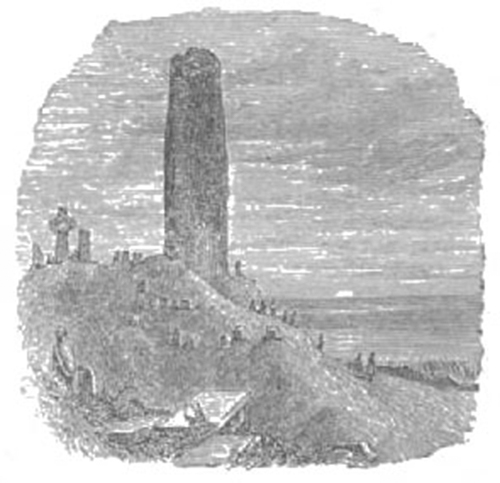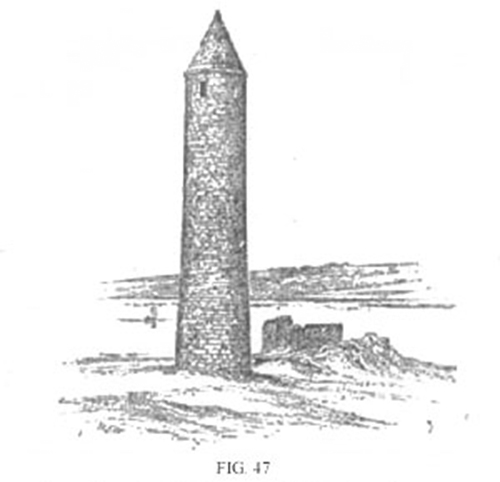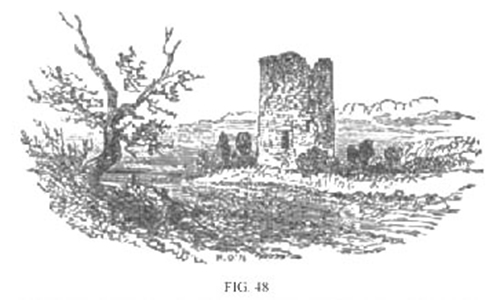Irish Round Towers
From A Smaller Social History of Ancient Ireland 1906
« previous page | contents | start of chapter | next page »
CHAPTER VI....continued
Round Towers.—In connexion with many of the ancient churches there were round towers of stone from 60 to 150 feet high, and from 13 to 20 feet in external diameter at the base: the top was conical. The interior was divided into six or seven stories reached by ladders from one to another, and each story was lighted by one window: the top story had usually four windows. The door was placed 10 or more feet from the ground outside, and was reached by a ladder: both doors and windows had sloping jambs like those of the churches. About eighty round towers still remain, of which about twenty are perfect: the rest are more or less imperfect.
Formerly there was much speculation as to the uses of these round towers; but Dr. George Petrie, after examining the towers themselves, and—with the help of O'Donovan and O'Curry—searching through all the Irish literature within his reach for allusions to them, set the question at rest in his Essay on "The Origin and Uses of the Round Towers." It is now known that they are of Christian origin, and that they were always built in connexion with ecclesiastical establishments.
FIG. 46. Great Tower, Clonmacnoise. (From Petrie's Round Towers).
They were erected at various times from about the beginning of the ninth to the thirteenth century. They had at least a twofold use: as belfries, and as keeps to which the inmates of the monastery retired with their valuables —such as books, shrines, crosiers, relics, and vestments—in case of sudden attack. They were probably used also—when occasion required—as beacons and watch-towers. These are Dr. Petrie's conclusions, but he fixed the date of some few in the fifth century, which recent investigations have shown to be too early.
FIG. 47. Round Tower (perfect), Devenish Island, in Lough Erne, near Enniskillen. (From Kilkenny Archaeological Journal). For another view, with church, see chap. xx., sect. 5, infra.
It would appear that it was the Danish incursions that gave rise to the erection of the round towers, which began to be built early in the ninth century simultaneously all over the country. They were admirably suited to the purpose of affording refuge from the sudden murderous raids of the Norsemen: for the inmates could retire with their valuables on a few minutes' warning, with a good supply of large stones to drop on the robbers from the windows; and once they had drawn up the outside ladder and barred the door, the tower was, for a short attack, practically impregnable. Round towers are not quite peculiar to Ireland; about twenty-two are found elsewhere—in Bavaria, Italy, Switzerland, Belgium, Scotland, and other countries.
FIG. 48. Remains of Round Tower at Drumcliff, 4 miles north of Sligo town: built near the church founded by St. Columkille; but long after his time.
Monastic Lis or Rampart —An Irish monastery, including the whole group of monastic buildings, was generally enclosed by a strong rampart, commonly circular or oval, according to the fashion of the country in the lay homesteads. The rampart was designated by one of the usual Irish names, rath, or lios [liss], or if of stone, caiseal [cashel].



